Precision Carbon Stock Estimation in Urban Campuses Using Fused Backpack and UAV LiDAR Data
Abstract
1. Introduction
2. Materials and Methods
2.1. Study Area
2.2. Datasets
2.2.1. Lidar Data Acquisition
2.2.2. Field Survey
2.3. Methods
2.3.1. Preprocessing
2.3.2. Individual Tree Segmentation
2.3.3. Estimation of Carbon Storage
| Species | Allometric Biomass Models | Source |
|---|---|---|
| Cinnamomum camphora (L.) J.Presl. | B = 0.937 + 0.037D2H | [32] |
| Liriodendron chinense (Hemsl.) Sarg. | B = 0.06393D2.61147 | [33] |
| Metasequoia glyptostroboides Hu & W. C. Cheng | B = Exp(−0.8168 + 2.1549lnD) | [32] |
| Lagerstroemia indica L. | B = 0.895 + 0.035D2H | [32] |
| Cedrus deodara (Roxb. ex D. Don) G. Don | B = 1.26(0.3721D1.2928 + 0.2805D1.3313) | [33] |
| Juniperus chinensis L. | B = 0.0707(D2H)0.8374 + 0.0054(D2H)1.0078 + 0.0048(D2H)1.0045 + 0.0058(D2H)0.6646 | [34] |
| Salix babylonica L. | B = 0.178D2.581 | [32] |
| Liquidambar formosana Hance | B = 0.1511D7/3 | [35] |
| Ginkgo biloba L. | B = 0.044 + 0.042D2H | [32] |
| Magnolia grandiflora L. | B = 0.33079D1.90957 | [33] |
| Platanus orientalis L. | B = 0.0690(D2H)0.9133 | [33] |
| Broussonetia papyrifera (L.) L’Hér. ex Vent. | B = 0.0017579(D2H)1.5784 | [32] |
| Koelreuteria paniculate Franch. | B = 0.915 + 0.1D2H | [32] |
| broad-leaved tree | B = Exp(−3.5618 + 2.6645lnD) | [33] |
2.3.4. Accuracy Evaluation
3. Results
3.1. Results and Analysis of Individual Tree Recognition
3.2. Results and Analysis of DBH Fitting
3.3. Estimation Results of Carbon Storage
4. Discussion
4.1. Factors Affecting Individual Tree Recognition
4.2. Sources of DBH Fitting Error
5. Conclusions
Author Contributions
Funding
Data Availability Statement
Acknowledgments
Conflicts of Interest
References
- Xie, D.; Feng, L.; Yan, X.; Sharma, R.P.; Wang, Z.; Duan, G.; Tang, S.; Liu, S.; Fu, L. forestat: An R package for computing forest carbon sequestration and potential productivity. Ecol. Indic. 2024, 166, 112477. [Google Scholar] [CrossRef]
- Feng, T.; Qi, Y.; Zhang, Y.; Fan, D.; Wei, T.; Wang, P.; Keesstra, S.D.; Cerdà, A. Long-term effects of vegetation restoration and forest management on carbon pools and nutrient storages in northeastern Loess Plateau, China. J. Environ. Manag. 2024, 354, 120296. [Google Scholar] [CrossRef] [PubMed]
- Gülçin, D.; van Den Bosch, C.C.K. Assessment of above-ground carbon storage by urban trees using LiDAR data: The case of a university campus. Forests 2021, 12, 62. [Google Scholar] [CrossRef]
- Schick, M.; Griffin, R.; Cherrington, E.; Sever, T. Utilizing LiDAR to quantify aboveground tree biomass within an urban university. Urban For. Urban Green. 2023, 89, 128098. [Google Scholar] [CrossRef]
- Wang, C.; Parvez, A.; Mou, J.; Quan, C.; Wang, J.; Zheng, Y.; Luo, X.; Wu, T. The status and improvement opportunities towards carbon neutrality of a university campus in China: A case study on energy transition and innovation perspectives. J. Clean. Prod. 2023, 414, 137521. [Google Scholar] [CrossRef]
- Zhang, L.; Shao, Z.; Liu, J.; Cheng, Q. Deep learning based retrieval of forest aboveground biomass from combined LiDAR and Landsat 8 data. Remote Sens. 2019, 11, 1459. [Google Scholar] [CrossRef]
- Jiang, X.; Li, G.; Lu, D.; Chen, E.; Wei, X. Stratification-based forest aboveground biomass estimation in a subtropical region using airborne lidar data. Remote Sens. 2020, 12, 1101. [Google Scholar] [CrossRef]
- Wang, L.; Ju, Y.; Ji, Y.; Marino, A.; Zhang, W.; Jing, Q. Estimation of forest above-ground biomass in the study area of Greater Khingan ecological station with integration of airborne LiDAR, Landsat 8 OLI, and hyperspectral remote sensing data. Forests 2024, 15, 1861. [Google Scholar] [CrossRef]
- Kabiri, K. Mapping coastal ecosystems and features using a low-cost standard drone: Case study, Nayband Bay, Persian gulf, Iran. J. Coast. Conserv. 2020, 24, 62. [Google Scholar] [CrossRef]
- Karimi, A.; Abtahi, B.; Kabiri, K. Mapping and Estimating Blue Carbon in Mangrove Forests Using Drone and Field-Based Tree Height Data: A Cost-Effective Tool for Conservation and Management. Forests 2025, 16, 1196. [Google Scholar] [CrossRef]
- Zhao, K.; Suarez, J.C.; Garcia, M.; Hu, T.; Wang, C.; Londo, A. Utility of multitemporal lidar for forest and carbon monitoring: Tree growth, biomass dynamics, and carbon flux. Remote Sens. Environ. 2018, 204, 883–897. [Google Scholar] [CrossRef]
- Liu, Y.; Chen, D.; Na, J.; Peethambaran, J.; Pfeifer, N.; Zhang, L. Segmentation of Individual Trees in TLS Point Clouds via Graph Optimization. IEEE Trans. Geosci. Remote Sens. 2025, 63, 5702821. [Google Scholar] [CrossRef]
- Li, L.; Wei, L.; Li, N.; Zhang, S.; Hu, M.; Ma, J. Impact of backpack LiDAR scan routes on diameter at breast height estimation in forests. Forests 2025, 16, 527. [Google Scholar] [CrossRef]
- Ma, S.; Chen, Y.; Li, Z.; Chen, J.; Zhong, X. Improved cylinder-based tree trunk detection in LiDAR point clouds for forestry applications. Sensors 2025, 25, 714. [Google Scholar] [CrossRef]
- Wang, C.; Luo, S.; Xi, X.; Nie, S.; Ma, D.; Huang, Y. Influence of voxel size on forest canopy height estimates using full-waveform airborne LiDAR data. For. Ecosyst. 2020, 7, 31. [Google Scholar] [CrossRef]
- Wang, A.; Wang, J.; Li, H.; Hu, J.; Zhou, H.; Zhang, X.; Liu, X.; Wang, W.; Zhang, W.; Wu, S.; et al. Tree parameter extraction method based on new remote sensing technology and terrestrial laser scanning technology. Big Data Res. 2024, 36, 100460. [Google Scholar] [CrossRef]
- Zhang, Z.; Cao, L.; She, G. Estimating forest structural parameters using canopy metrics derived from airborne LiDAR data in subtropical forests. Remote Sens. 2017, 9, 940. [Google Scholar] [CrossRef]
- Zhang, Z.; Wang, T.; Skidmore, A.K.; Cao, F.; She, G.; Cao, L. An improved area-based approach for estimating plot-level tree DBH from airborne LiDAR data. For. Ecosyst. 2023, 10, 100089. [Google Scholar] [CrossRef]
- Liu, C.; Xing, Y.; Duanmu, J.; Tian, X. Evaluating different methods for estimating diameter at breast height from terrestrial laser scanning. Remote Sens. 2018, 10, 513. [Google Scholar] [CrossRef]
- Ali, J.S.; Chen, L.; Liao, B.; Wang, C.; Zhang, F.; Bhutto, Y.A.; Junejo, S.A.; Nian, Y. Integration of UAS and Backpack-LiDAR to Estimate Aboveground Biomass of Picea crassifolia Forest in Eastern Qinghai, China. Remote Sens. 2025, 17, 681. [Google Scholar] [CrossRef]
- Fan, G.; Nan, L.; Chen, F.; Dong, Y.; Wang, Z.; Li, H.; Chen, D. A new quantitative approach to tree attributes estimation based on LiDAR point clouds. Remote Sens. 2020, 12, 1779. [Google Scholar] [CrossRef]
- Zheng, G.; Ma, L.; Eitel, J.U.; He, W.; Magney, T.S.; Moskal, L.M.; Li, M. Retrieving directional gap fraction, extinction coefficient, and effective leaf area index by incorporating scan angle information from discrete aerial lidar data. IEEE Trans. Geosci. Remote Sens. 2016, 55, 577–590. [Google Scholar] [CrossRef]
- Wang, Y.; Fang, H.; Zhang, Y.; Li, S.; Pang, Y.; Ma, T.; Li, Y. Retrieval and validation of vertical LAI profile derived from airborne and spaceborne LiDAR data at a deciduous needleleaf forest site. GISci. Remote Sens. 2023, 60, 2214987. [Google Scholar] [CrossRef]
- Brede, B.; Calders, K.; Lau, A.; Raumonen, P.; Bartholomeus, H.M.; Herold, M.; Kooistra, L. Non-destructive tree volume estimation through quantitative structure modelling: Comparing UAV laser scanning with terrestrial LiDAR. Remote Sens. Environ. 2019, 233, 111355. [Google Scholar] [CrossRef]
- Ali, M.; Lohani, B.; Hollaus, M.; Pfeifer, N. Benchmarking geometry-based leaf-filtering algorithms for tree volume estimation using terrestrial LiDAR scanners. Remote Sens. 2024, 16, 1021. [Google Scholar] [CrossRef]
- Zhao, Y.; Im, J.; Zhen, Z.; Zhao, Y. Towards accurate individual tree parameters estimation in dense forest: Optimized coarse-to-fine algorithms for registering UAV and terrestrial LiDAR data. GISci. Remote Sens. 2023, 60, 2197281. [Google Scholar] [CrossRef]
- Kapoutsis, C.A.; Vavoulidis, C.P.; Pitas, I. Morphological iterative closest point algorithm. IEEE Trans. Image Process. 1999, 8, 1644–1646. [Google Scholar] [CrossRef]
- Li, L.; Wei, L.; Li, N.; Zhang, S.; Wu, Z.; Dong, M.; Chen, Y. Extracting the DBH of moso bamboo forests using LiDAR: Parameter optimization and accuracy evaluation. Forests 2024, 15, 804. [Google Scholar] [CrossRef]
- Zhang, W.; Qi, J.; Wan, P.; Wang, H.; Xie, D.; Wang, X.; Yan, G. An easy-to-use airborne LiDAR data filtering method based on cloth simulation. Remote Sens. 2016, 8, 501. [Google Scholar] [CrossRef]
- Tao, S.; Wu, F.; Guo, Q.; Wang, Y.; Li, W.; Xue, B.; Hu, X.; Li, P.; Tian, D.; Li, C.; et al. Segmenting tree crowns from terrestrial and mobile LiDAR data by exploring ecological theories. ISPRS J. Photogramm. Remote Sens. 2015, 110, 66–76. [Google Scholar] [CrossRef]
- IPCC. Guidelines for National Greenhouse Gas Inventories; Intergovernmental Panel on Climate Change: Geneva, Switzerland, 2006. [Google Scholar]
- Han, S. Study on the Comprehensive Effects of Water Saving and Carbon Fixation in Main Urban Road Greenbelts in Hangzhou. Master’s Thesis, Zhejiang A&F University, Hangzhou, China, 2023. [Google Scholar]
- Ma, L. Research on the Allocation Mode and Design Optimization of Carbon Sequestration Plants in Green Space in Residential Areas: A Case Study of Changqingfang, Xi’an. Master’s Thesis, Xi’an University of Architecture and Technology, Xi’an, China, 2023. [Google Scholar]
- Zhu, Y. Characteristics of Structure and Carbon Storage of Greening on the Campus of Anhui Agricultural University. Master’s Thesis, Anhui Agricultural University, Hefei, China, 2016. [Google Scholar]
- Zeng, W. Developing one-variable individual tree biomass models based on wood density for 34 Tree Species in China. For. Resour. Manag. 2017, 6, 41–46. [Google Scholar]
- Wang, D.; Liang, X.; Mofack, G.I.; Martin-Ducup, O. Individual tree extraction from terrestrial laser scanning data via graph pathing. For. Ecosyst. 2021, 8, 67. [Google Scholar] [CrossRef]
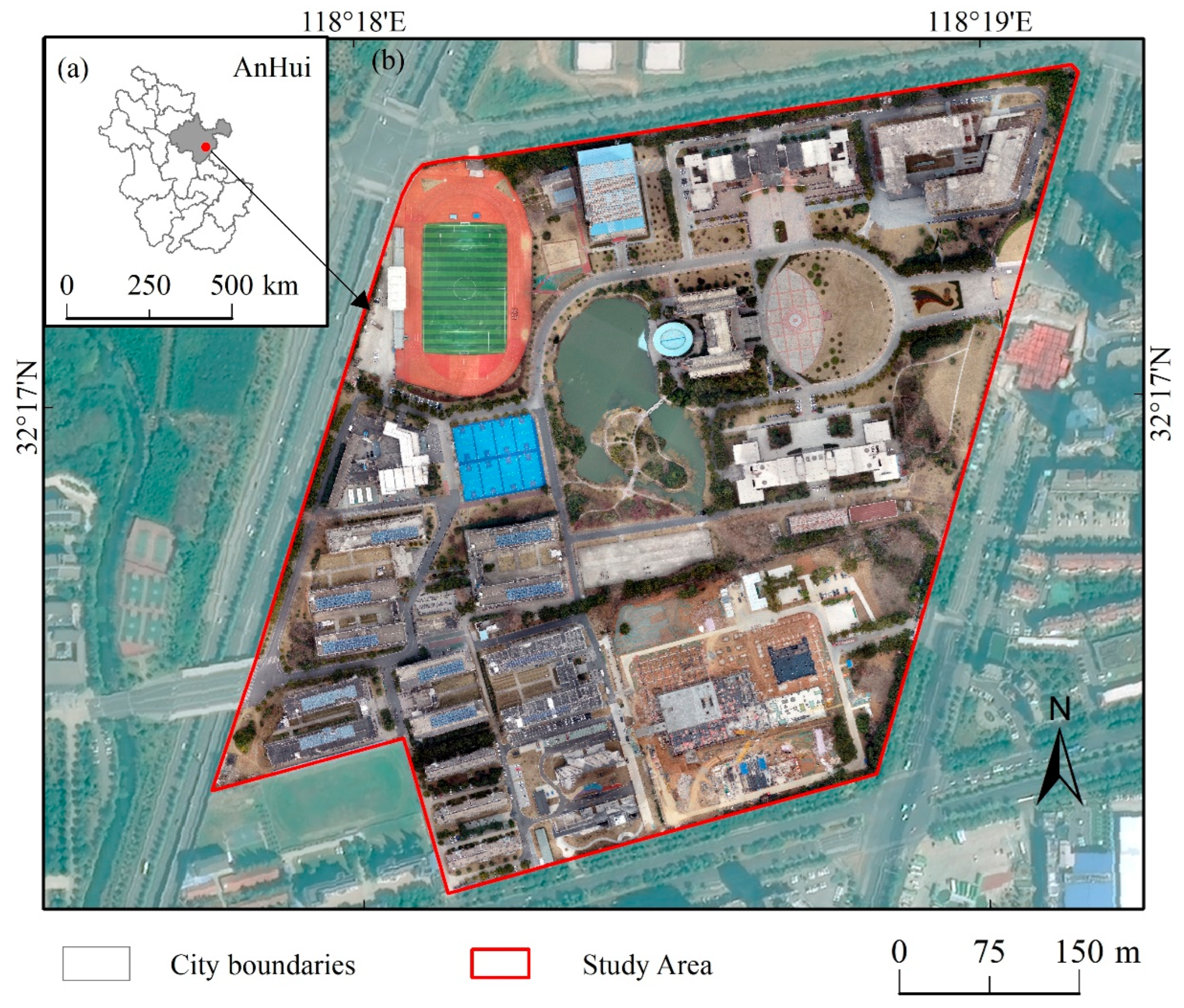
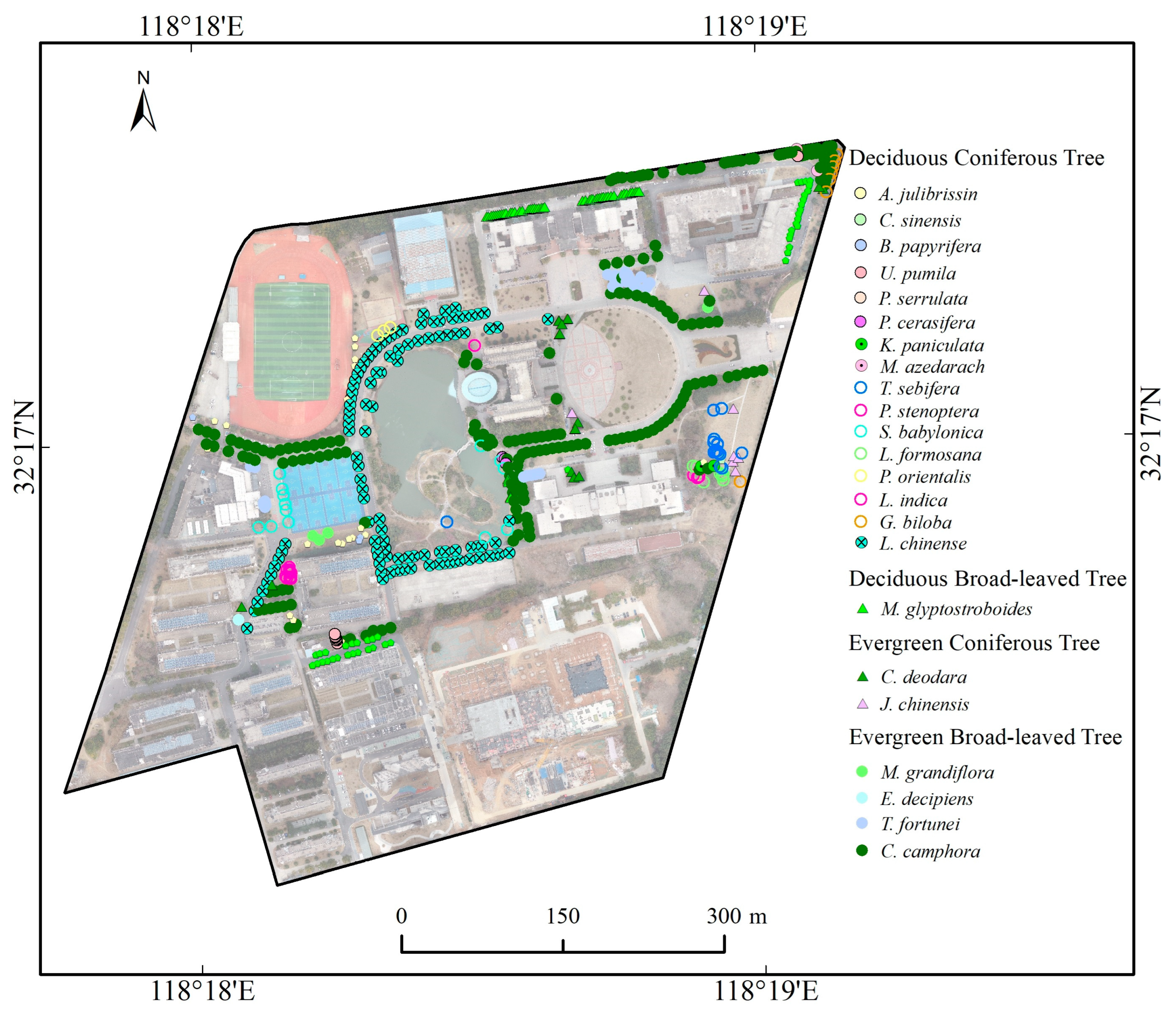
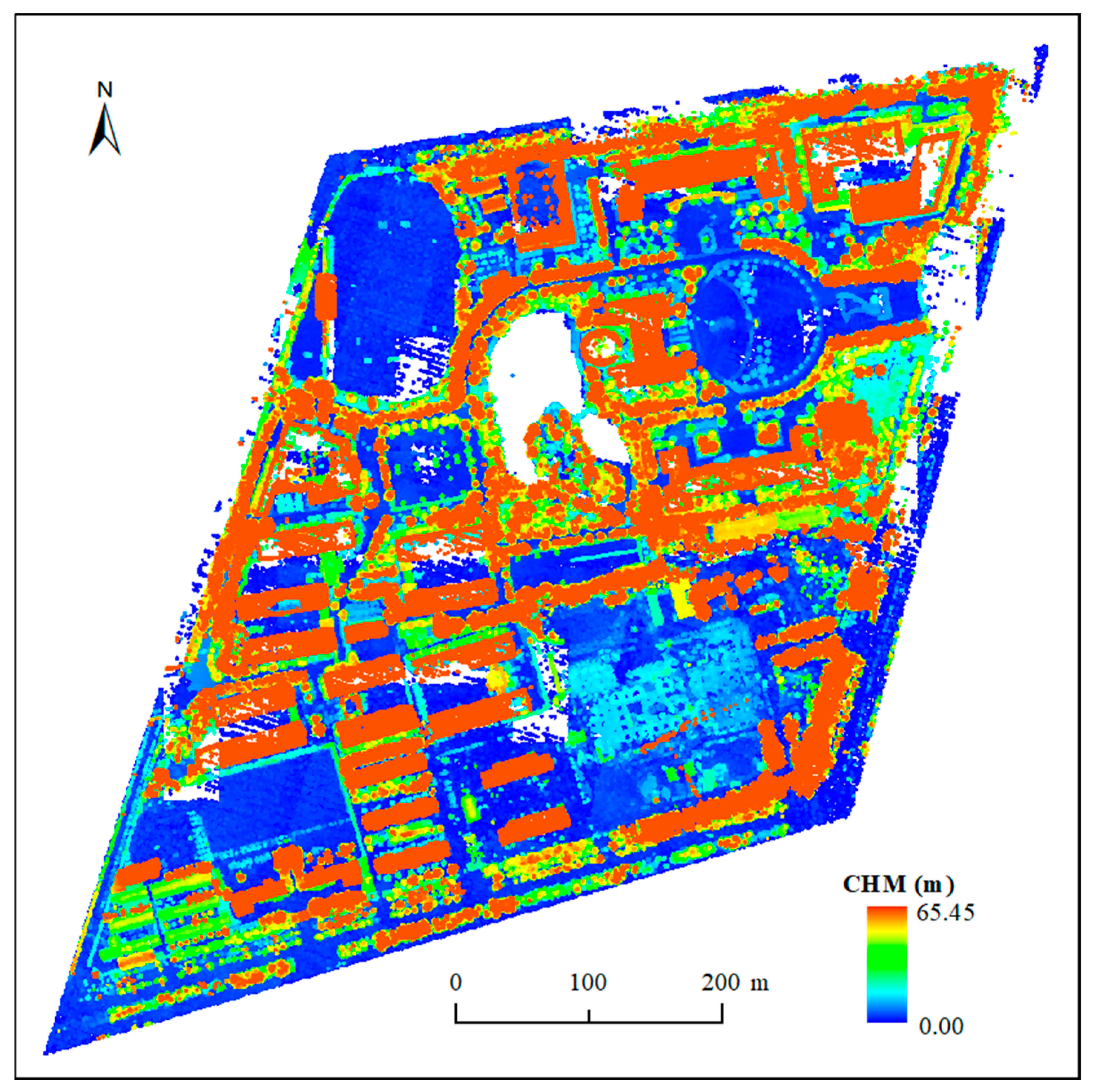

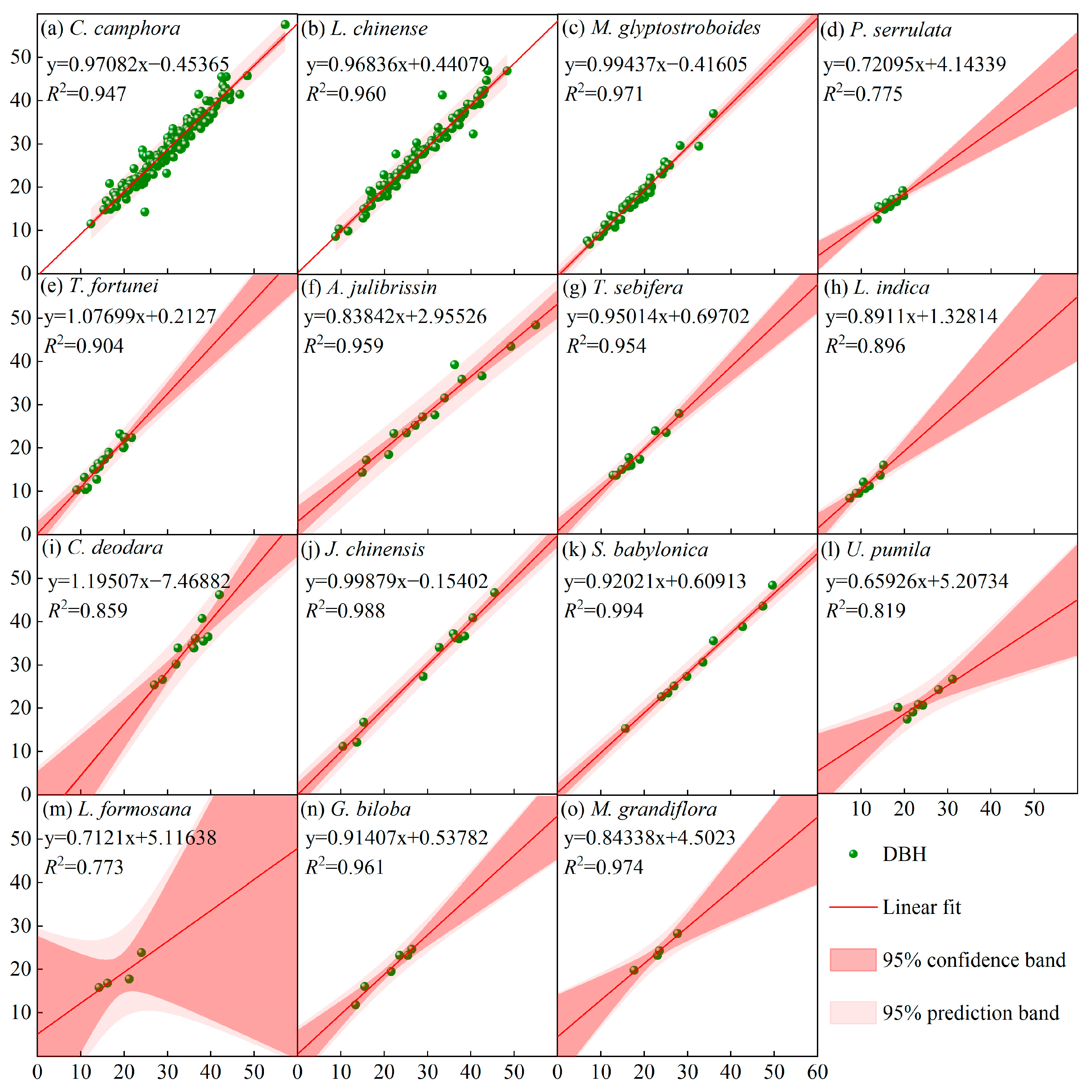
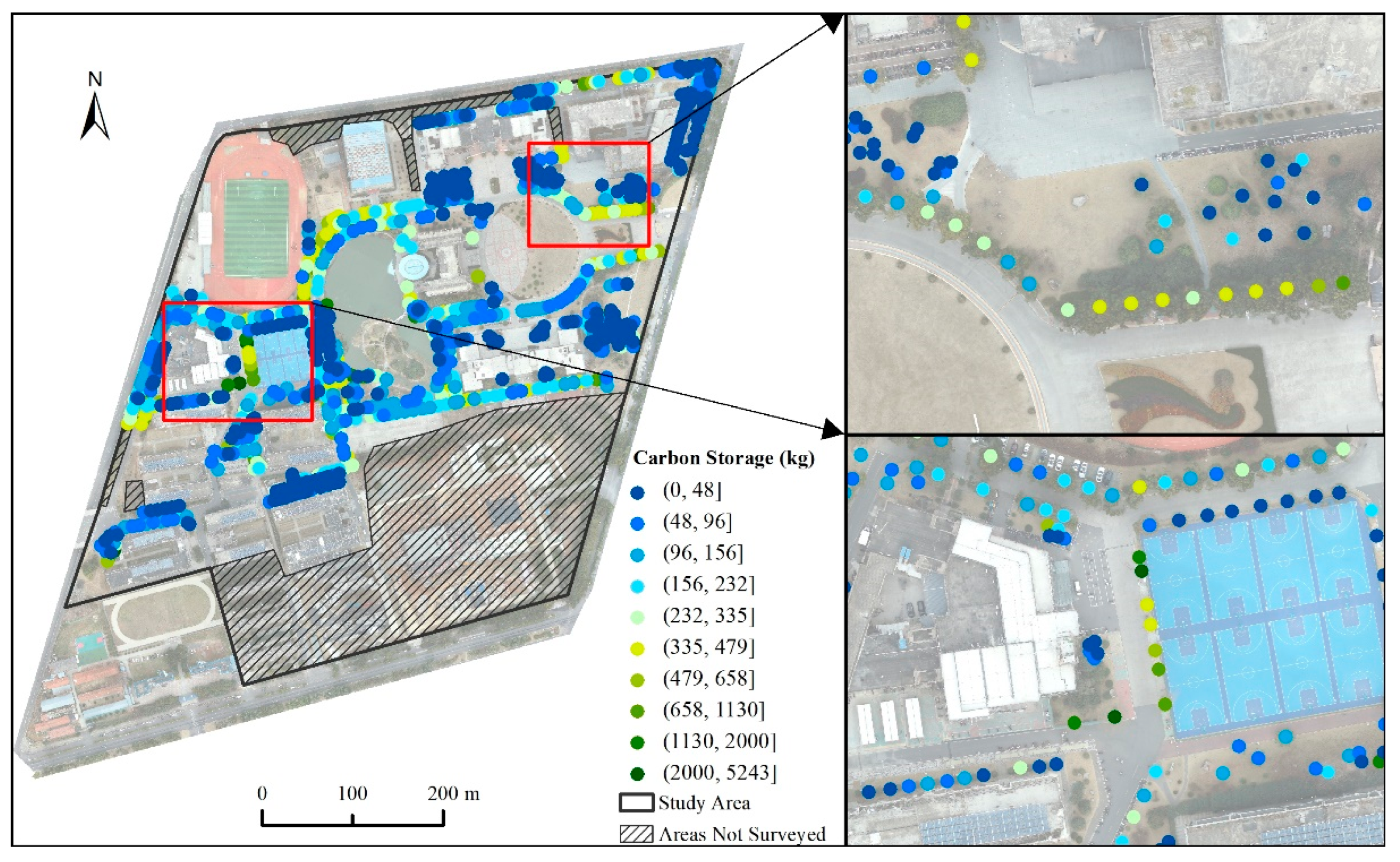
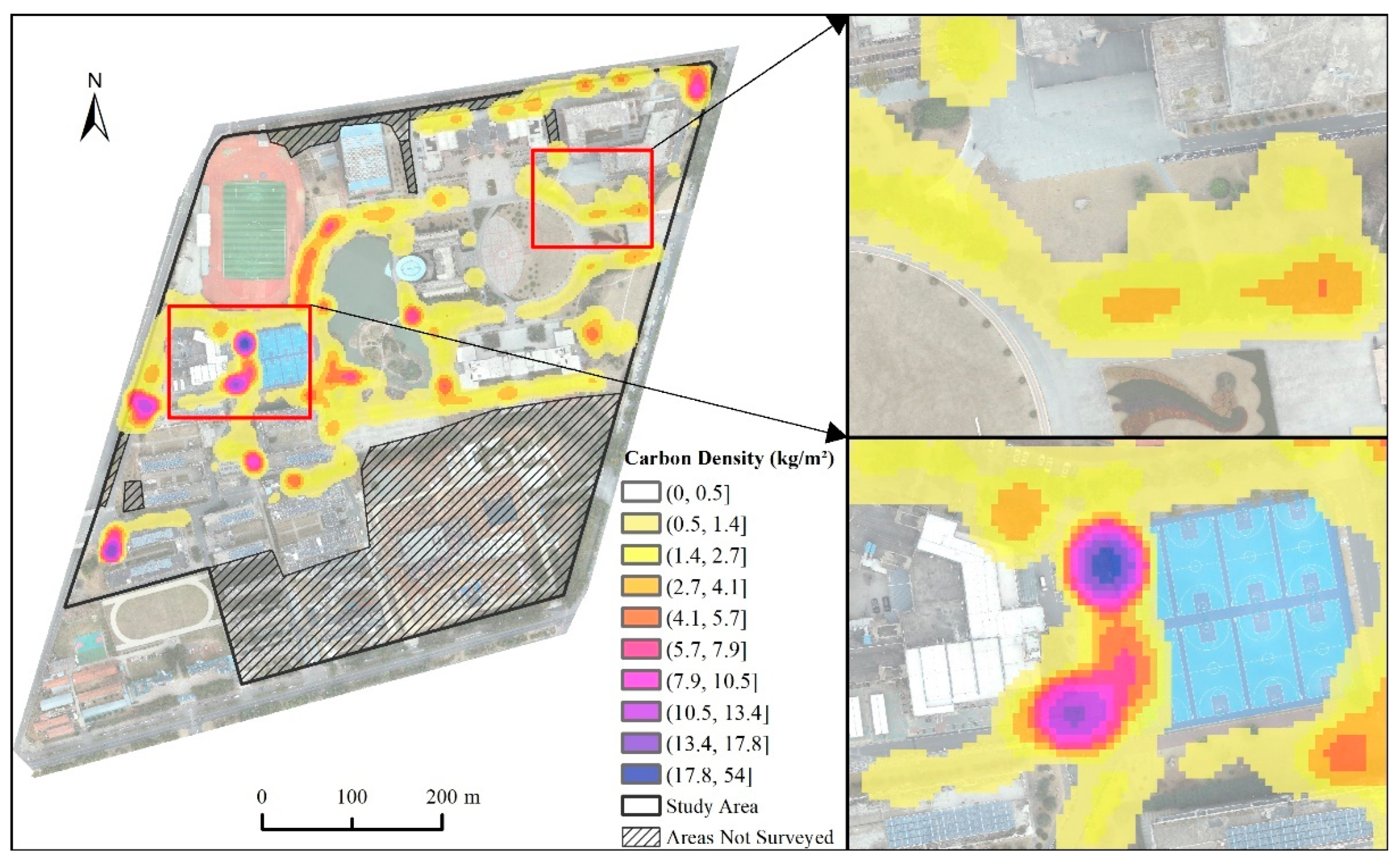


| Performance Indicators | LiAir 250 | Li-Backpack DGC50 |
|---|---|---|
| Laser Sensor | Riegl mini VUX-1UAV | VLP16 |
| Relative Precision | ±3 cm | ±3 cm |
| Absolute Precision | ±5 cm | ±5 cm |
| Measurement Rate | 1,000,000 pts/s | 640,000 pts/s |
| Field of View | 360° | Horizontal 280–360° Vertical ± 90° |
| Scanning Distance | 3–250 m | 120 m |
| Photo | 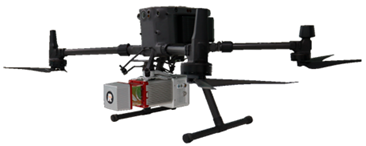 |  |
| Species | Number of Trees | DBH/cm | ||
|---|---|---|---|---|
| Minimum | Maximum | Average | ||
| Cinnamomum camphora (L.) J.Presl. | 208 | 7.8 | 57.2 | 29.9 |
| Liriodendron chinense (Hemsl.) Sarg. | 107 | 8.7 | 48.3 | 28.1 |
| Metasequoia glyptostroboides Hu & W. C. Cheng | 51 | 6.8 | 35.9 | 18.1 |
| Prunus serrulata Lindl. | 43 | 9.0 | 21.6 | 15.6 |
| Trachycarpus fortunei (Hook.) H. Wendl. | 30 | 9.1 | 26.7 | 15.7 |
| Albizia julibrissin Durazz. | 21 | 14.9 | 54.9 | 30.4 |
| Triadica sebifera (L.) Small | 15 | 12.8 | 40.4 | 19.7 |
| Lagerstroemia indica L. | 14 | 7.5 | 15.2 | 11.7 |
| Cedrus deodara (Roxb. ex D. Don) G. Don | 13 | 27 | 50.3 | 36.1 |
| Juniperus chinensis L. | 13 | 9.6 | 45.5 | 30.0 |
| Salix babylonica L. | 13 | 15.7 | 71.0 | 39.6 |
| Ulmus pumila L. | 9 | 11.8 | 31.2 | 21.8 |
| Liquidambar formosana Hance | 8 | 12.3 | 24.0 | 17.6 |
| Ginkgo biloba L. | 7 | 11.0 | 26.4 | 19.6 |
| Magnolia grandiflora L. | 4 | 17.7 | 27.7 | 23.0 |
| Prunus cerasifera Ehrh. | 3 | 14.3 | 27.6 | 20.6 |
| Platanus orientalis L. | 3 | 45.7 | 59.7 | 51.6 |
| Broussonetia papyrifera (L.) L’Hér. ex Vent. | 3 | 21.0 | 27.1 | 23.5 |
| Koelreuteria paniculate Franch. | 2 | 14.2 | 27.1 | 20.7 |
| Melia azedarach L. | 2 | 18.2 | 27.0 | 22.6 |
| Celtis sinensis Pers. | 1 | 5.4 | 5.4 | 5.4 |
| Pterocarya stenoptera C. DC. | 1 | 34.3 | 34.3 | 34.3 |
| Elaeocarpus decipiens Hemsl. | 1 | 31.2 | 31.2 | 31.2 |
| Species | Nr | Nd | Nc | Pd (%) | Pr (%) | F (%) |
|---|---|---|---|---|---|---|
| Cinnamomum camphora (L.) J.Presl. | 301 | 321 | 274 | 85.36 | 91.03 | 88.10 |
| Liriodendron chinense (Hemsl.) Sarg. | 166 | 171 | 154 | 90.06 | 92.77 | 91.39 |
| Metasequoia glyptostroboides Hu & W. C. Cheng | 72 | 72 | 68 | 94.44 | 94.44 | 94.44 |
| Prunus serrulata Lindl. | 56 | 59 | 53 | 89.83 | 94.64 | 92.17 |
| Trachycarpus fortunei (Hook.) H. Wendl. | 80 | 81 | 75 | 92.59 | 93.75 | 93.17 |
| Albizia julibrissin Durazz. | 29 | 31 | 26 | 83.87 | 89.66 | 86.67 |
| Triadica sebifera (L.) Small | 23 | 38 | 17 | 44.74 | 73.91 | 55.74 |
| Lagerstroemia indica L. | 24 | 25 | 23 | 92.00 | 95.83 | 93.88 |
| Cedrus deodara (Roxb. ex D. Don) G. Don | 41 | 118 | 17 | 14.41 | 41.46 | 21.38 |
| Juniperus chinensis L. | 13 | 14 | 12 | 85.71 | 92.31 | 88.89 |
| Salix babylonica L. | 27 | 98 | 14 | 14.29 | 51.85 | 22.40 |
| Ulmus pumila L. | 9 | 10 | 8 | 80.00 | 88.89 | 84.21 |
| Liquidambar formosana Hance | 9 | 9 | 9 | 100.00 | 100.00 | 100.00 |
| Ginkgo biloba L. | 7 | 7 | 7 | 100.00 | 100.00 | 100.00 |
| Magnolia grandiflora L. | 4 | 5 | 3 | 60.00 | 75.00 | 66.67 |
| Prunus cerasifera Ehrh. | 3 | 3 | 3 | 100.00 | 100.00 | 100.00 |
| Platanus orientalis L. | 3 | 3 | 3 | 100.00 | 100.00 | 100.00 |
| Broussonetia papyrifera (L.) L’Hér. ex Vent. | 6 | 7 | 5 | 71.43 | 83.33 | 76.92 |
| Koelreuteria paniculate Franch. | 16 | 16 | 16 | 100.00 | 100.00 | 100.00 |
| Melia azedarach L. | 2 | 2 | 1 | 50.00 | 50.00 | 50.00 |
| Celtis sinensis Pers. | 1 | 1 | 1 | 100.00 | 100.00 | 100.00 |
| Pterocarya stenoptera C. DC. | 4 | 4 | 4 | 100.00 | 100.00 | 100.00 |
| Elaeocarpus decipiens Hemsl. | 1 | 1 | 1 | 100.00 | 100.00 | 100.00 |
| All Tree | 897 | 1096 | 794 | 72.45% | 88.52 | 79.68 |
| Species | P (%) | R2 | RMSE (cm) | rRMSE (%) |
|---|---|---|---|---|
| Cinnamomum camphora (L.) J.Presl. | 93.19 | 0.947 | 2.24 | 7.45 |
| Liriodendron chinense (Hemsl.) Sarg. | 95.11 | 0.960 | 1.81 | 6.44 |
| Metasequoia glyptostroboides Hu & W. C. Cheng | 94.38 | 0.971 | 1.15 | 6.38 |
| Prunus serrulata Lindl. | 94.84 | 0.775 | 0.95 | 5.67 |
| Trachycarpus fortunei (Hook.) H. Wendl. | 90.10 | 0.904 | 1.92 | 12.36 |
| Albizia julibrissin Durazz. | 90.68 | 0.959 | 3.45 | 10.95 |
| Triadica sebifera (L.) Small | 95.26 | 0.954 | 1.01 | 5.50 |
| Lagerstroemia indica L. | 93.42 | 0.896 | 0.81 | 7.26 |
| Cedrus deodara (Roxb. ex D. Don) G. Don | 93.82 | 0.859 | 2.35 | 6.70 |
| Juniperus chinensis L. | 95.18 | 0.988 | 1.29 | 4.23 |
| Salix babylonica L. | 93.49 | 0.994 | 2.79 | 7.63 |
| Ulmus pumila L. | 84.13 | 0.819 | 3.49 | 14.56 |
| Liquidambar formosana Hance | 91.70 | 0.773 | 1.90 | 10.07 |
| Ginkgo biloba L. | 92.34 | 0.961 | 1.61 | 7.67 |
| Magnolia grandiflora L. | 95.89 | 0.974 | 1.16 | 5.06 |
| Species | Nr | Average Carbon Storage per Plant (kg) | Carbon Storage (kg) |
|---|---|---|---|
| Cinnamomum camphora (L.) J.Presl. | 301 | 174.8 | 52,621 |
| Liriodendron chinense (Hemsl.) Sarg. | 166 | 222.7 | 36,971 |
| Metasequoia glyptostroboides Hu & W. C. Cheng | 72 | 201.0 | 14,474 |
| Prunus serrulata Lindl. | 56 | 33.5 | 1878 |
| Trachycarpus fortunei (Hook.) H. Wendl. | 80 | 57.9 | 4633 |
| Albizia julibrissin Durazz. | 29 | 100.2 | 2907 |
| Triadica sebifera (L.) Small | 23 | 39.6 | 911 |
| Lagerstroemia indica L. | 24 | 40.9 | 981 |
| Cedrus deodara (Roxb. ex D. Don) G. Don | 41 | 36.0 | 1476 |
| Juniperus chinensis L. | 13 | 82.4 | 1071 |
| Salix babylonica L. | 27 | 1256.6 | 33,928 |
| Ulmus pumila L. | 9 | 72.6 | 653 |
| Liquidambar formosana Hance | 9 | 78.7 | 708 |
| Ginkgo biloba L. | 7 | 77.9 | 545 |
| Magnolia grandiflora L. | 4 | 82.5 | 330 |
| Prunus cerasifera Ehrh. | 3 | 48.0 | 144 |
| Platanus orientalis L. | 3 | 466.0 | 1398 |
| Broussonetia papyrifera (L.) L’Hér. ex Vent. | 6 | 330.3 | 1982 |
| Koelreuteria paniculate Franch. | 16 | 345.1 | 5521 |
| Melia azedarach L. | 2 | 56.0 | 112 |
| Celtis sinensis Pers. | 1 | 4.0 | 4 |
| Pterocarya stenoptera C. DC. | 4 | 67.5 | 270 |
| Elaeocarpus decipiens Hemsl. | 1 | 82.0 | 82 |
| All tree | 897 | 182.4 | 163,601 |
Disclaimer/Publisher’s Note: The statements, opinions and data contained in all publications are solely those of the individual author(s) and contributor(s) and not of MDPI and/or the editor(s). MDPI and/or the editor(s) disclaim responsibility for any injury to people or property resulting from any ideas, methods, instructions or products referred to in the content. |
© 2025 by the authors. Licensee MDPI, Basel, Switzerland. This article is an open access article distributed under the terms and conditions of the Creative Commons Attribution (CC BY) license (https://creativecommons.org/licenses/by/4.0/).
Share and Cite
Zhang, S.; Li, N.; Li, L.; Liu, Y.; Wang, H.; Xue, T.; Ma, J.; Hu, M. Precision Carbon Stock Estimation in Urban Campuses Using Fused Backpack and UAV LiDAR Data. Forests 2025, 16, 1550. https://doi.org/10.3390/f16101550
Zhang S, Li N, Li L, Liu Y, Wang H, Xue T, Ma J, Hu M. Precision Carbon Stock Estimation in Urban Campuses Using Fused Backpack and UAV LiDAR Data. Forests. 2025; 16(10):1550. https://doi.org/10.3390/f16101550
Chicago/Turabian StyleZhang, Shijun, Nan Li, Longwei Li, Yuchan Liu, Hong Wang, Tingting Xue, Jing Ma, and Mengyi Hu. 2025. "Precision Carbon Stock Estimation in Urban Campuses Using Fused Backpack and UAV LiDAR Data" Forests 16, no. 10: 1550. https://doi.org/10.3390/f16101550
APA StyleZhang, S., Li, N., Li, L., Liu, Y., Wang, H., Xue, T., Ma, J., & Hu, M. (2025). Precision Carbon Stock Estimation in Urban Campuses Using Fused Backpack and UAV LiDAR Data. Forests, 16(10), 1550. https://doi.org/10.3390/f16101550







